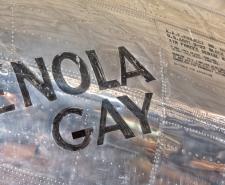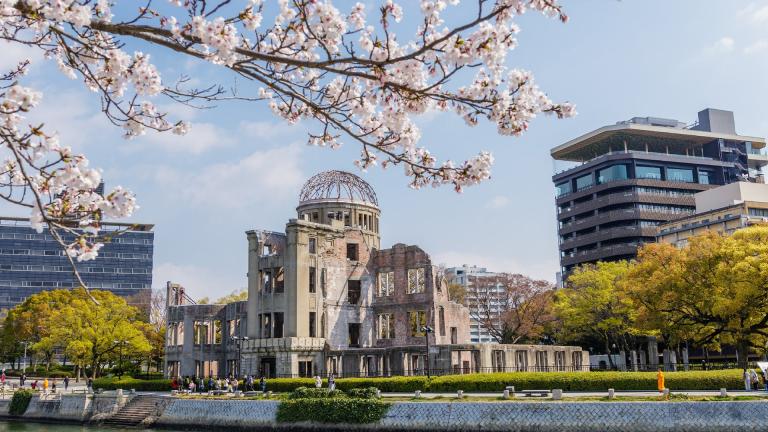
Read more about WW2

This year marks the 80th anniversary of Victory over Japan Day, when Imperial Japan officially offered its surrender to mark the beginning of the end of World War II. The formal ceremony occurred on 2nd September 1945, but the announcement on 15th August prompted widespread celebrations around the world. Visit Sky HISTORY's VJ Day 80 hub to learn more about what happened and the events that led up to that moment.
80 years ago, the sky above Hiroshima cracked open. At 8:15am on 6th August 1945, the first atomic bomb used in war detonated over a city that, until then, had largely been spared the destruction seen elsewhere in Japan. In a flash, homes, schools and families were gone.
At Sky HISTORY, we’re always interested in moments that shaped the world as we know it. Hiroshima is one of those moments.
By summer 1945, World War II had ground on for nearly six years. Hitler was gone but Japan was still fighting. The US had warned of 'utter destruction' if the country didn’t surrender. What they hadn’t made public was that a new kind of bomb was ready.
On 16th July, scientists tested it in the New Mexico desert. Three weeks later, it was headed for Hiroshima.
The city was chosen for strategic reasons. It was a military hub, home to thousands of troops and key infrastructure. It was also a city of civilians, like any other.
When the bomb dropped by Colonel Paul Tibbets exploded above Hiroshima, the fireball reached temperatures hotter than the surface of the sun. Buildings within two kilometres were obliterated. Others caught fire, collapsed, or both. People literally evaporated.
'The whole sky lit up when it exploded,' recalls Tibbets. 'There was nothing but a black boiling mess hanging over the city… you wouldn't have known… Hiroshima was there.'
The death toll is impossible to calculate exactly, but estimates put it at 70,000 to 80,000 killed instantly. Another 70,000 would die in the following weeks from injuries and radiation. More still in the years that followed.
And those numbers don’t tell you what it sounded like. What it smelled like. What it meant for someone who had just sent their child to school that morning and never saw them again.
Three days after Hiroshima, the US dropped another bomb. This time on Nagasaki. On 15th August, Japan surrendered. The war was over.
But for Hiroshima, it was only the beginning. The city was unrecognisable and the aftermath was horrifying. Survivors (now known as the hibakusha) faced extreme injuries, radiation sickness and lifelong health issues. Many were ostracised, seen as damaged or unlucky.
Hiroshima didn’t just change warfare. It forced a new kind of reckoning: what happens when we create something capable of ending the world?
The atomic age was born that morning and the Cold War followed. So did stockpiles, treaties, summits and near-misses. And though the global mood has shifted since, Hiroshima remains a benchmark. A warning that science without ethics, or power without restraint, can reshape the world in seconds.
That’s the political legacy. But there’s a human one too.
The hibakusha who came forward and tell their stories did so not for drama, but to prevent forgetting. And hopefully, to prompt people to ask the question, what if Hiroshima and Nagasaki never happened?
Today, Hiroshima is full of life. The trams run. Kids walk to school. You can visit the Peace Park, cross the Motoyasu River and stand beneath the Memorial Dome. But the past hasn’t been forgotten. Especially not in 2025, the 80th anniversary of Hiroshima and Nagasaki. There will be moments of silence across the city on 9th August, as well as speeches, ceremonies and citizen-led peace initiatives.
And of course, one of the most enduring symbols to come out of Hiroshima is the Peace Crane Project, a global initiative inspired by the story of Sadako Sasaki. She was just two when the bomb fell and survived the blast but later developed what became known as 'atomic bomb disease'. The term is a catch-all for the cancers and conditions caused by radiation.
Sadako started folding paper cranes while in hospital, inspired by the Japanese belief that a thousand cranes might grant a wish. She never reached that number and sadly passed away when she was 12, but her cranes became a symbol of hope and peace. Today, the Peace Crane Project encourages children around the world fold cranes of their own, each one carrying a message of peace.
Want more like this? Sign up for the Sky HISTORY newsletter. We send weekly features straight to your inbox. Not just facts, but stories that stay with you.